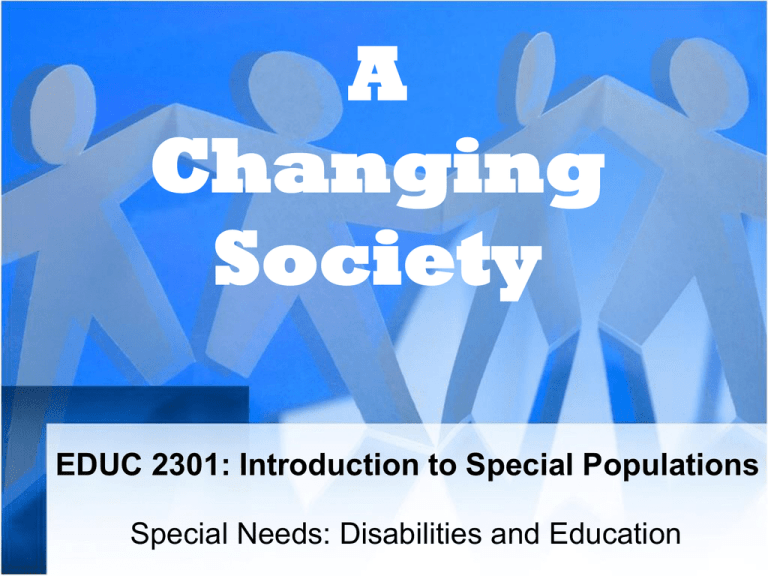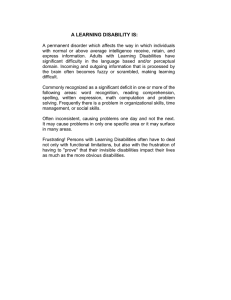
A
Changing
Society
EDUC 2301: Introduction to Special Populations
Special Needs: Disabilities and Education
LEARNING FROM PERSONS’ WITH
DISABILITIES STORIES
Every summer I went to summer school, and during the school
year I was in every little special group. I was in the speech group,
the corrective posture group, the purple reading group, the green
reading group. In third grade, the only word I could read was “the.”
I used to keep track of where the class was reading by following
from one “the” to the next…By the time I was 15 or 16, I could get
by in class with reading. But I could never spell. I was a workshop
major in high school, and my typical report card was two C’s, three
D’s, and an F. I just got used to it.
Paul Orfalea, founder and chairperson of Kinkos, Inc.
©2012 Cengage Learning.
All Rights Reserved.
HISTORICAL AND CURRENT TREATMENT IN THE
UNITED STATES
Throughout history, persons with disabilities
have been ignored, exiled, exploited, tortured,
and even destroyed. Nomadic societies saw
persons with disabilities as problems—actual
barriers to the group’s productivity because
people with disabilities were viewed as being
unable to contribute to their communities.
©2012 Cengage Learning.
All Rights Reserved.
Current Conditions
• The 2000 Census identified more than 56.7 million people with
disabilities living in the United States. 19% of population. 18.5
million of these individuals reported being employed. Both persons
with disabilities who were working and those not working stated a
need for similar types of accommodations.
• Even with advances in medicine, education, and laws attempting
to remove barriers that exclude individuals with disabilities, these
individuals continue to encounter discrimination ranging from
outright intentional exclusion and access to substandard services,
programs, activities, benefits, jobs, or other opportunities.
• 2009-2010 School year 6.4 million children
ages 3-21 received some form of special
education. That’s over 13% of the student
population
Special Education
• Specially designed instruction, at no cost to
parents, to meet the unique needs of a child
with a disability, including instruction conducted
in the classroom, in the home, in hospitals and
institution
• Students with disabilities are entitled to related
services such as transportation, occupational
and physical therapy, and psychological,
counseling, speech/language pathology,
audiology, and interpreting services.
Specially Designed Instruction
•
•
•
•
•
•
•
Intensive
Relentless
Structured
Appropriately paced
Small group
Frequent assessments
Specialized, designed instruction (for
blindness, deafness, behavior disorders)
PL 94-142 & Individuals with Disabilities
Education Act (IDEA)
• Public Law 94-142, the Education for All Handicapped
Children Act, mandated the following:
– Free appropriate education (FAPE)
– Learning in the least restrictive environment (LRE)
– Learning with the aid of an individualized education program
(IEP) designed to meet the student’s unique needs
– A plan to screen and identify students with disabilities
– Due process
– A nondiscriminatory evaluation
– Confidentiality
– Services performed by personnel who receive ongoing training
– IDEA Part B (ages 3-21) Part C (ages birth-2)
• http://idea.ed.gov/
ACCULTURATION AND EXPERIENCE WITH
EXCLUSION AND ALIENATION
• Inclusion for persons with disabilities in schooling
involves integrating students with disabilities in regular
classrooms whenever possible with the supports
necessary for them to succeed.
• This sometimes controversial policy differs from
mainstreaming which involves the placement of
students with identified disabilities in some “regular
education” classes when they have demonstrated that
they can function academically
within those classes without
additional help or resources.
©2012 Cengage Learning.
All Rights Reserved.
Benefits of Inclusion
• Higher academic achievement- graduation
rates for students with disabilities in the U.S.
increased by 14% from 1984 – 2005
• Higher self-esteem – By being included in a
regular paced education setting, children with
disabilities have shown to be more confident
and displayed qualities of raised self-efficacy.
• Better social skills- Learn social skills through
observation, gain a better understanding of the
world around them and become a part of the
“regular” community.
Least Restrictive Environment
• To the greatest
extent possible,
students with
disabilities must
be educated with
children who are
not disabled.
Benefits of Inclusion
• Educating non-disabled students and students with
disabilities together creates an atmosphere of
understanding and tolerance that better prepares
students of all abilities to function in the world beyond
school. Students without disabilities who engaged in an
inclusive physical education program reported
increases in self-concept, tolerance, self-worth, and a
better understanding of other people. Positive aspects
that come from inclusion are often attributed to contact
theory. Contact theory asserts that frequent,
meaningful, and pleasant interactions between people
with differences tend to produce changes in attitude.
Categories of Disabilities
• Learning Disabilities
• Speech or Language
impairment
• Mental Retardation
• Emotional
Disturbance
• Other Health
Impairments (ADHD)
• Multiple Disabilities
• Autism
• Orthopedic
Impairments
• Hearing Impairments
• Developmental Delay
• Visual Impairment
• Traumatic Brain
Injury (TBI)
• Deaf Blindness
Learning
Disabilities
Dyslexia
Dyscalculia
(reading)
(mathematics)
Dyslexia
• A learning disability that impairs a
person's fluency or accuracy in being able
to read, speak, and spell.
• Symptoms can include:
– delays in speech
– slow learning of new words
– difficulty in rhyming words
– low letter knowledge
– letter reversal or mirror writing (for example,
“d” instead of “b”).
Instructional Techniques for Students with
Learning Disabilities
•
•
•
•
Control task difficulty
Teach in small interactive groups
Use graphic organizers and visuals
Provide modeling and “think aloud”
strategies
• Use both direct instruction and cognitive
strategy instruction
• Teach self-regulation skills
• Provide opportunities for extended
practice with feedback
Speech Disorders
• Includes stuttering, muteness, speech
sound disorders, voice disorders/
impairments, dysphagia, receptive and
expressive
• How are students able to communicate
with you besides speech? Is speech
required to master content?
• Treatment usually involves the services of
a speech pathologist in or out of the
classroom.
• Stuttering
Creating accepting classroom community
for students with speech disorders
• Create atmosphere of comfort avoiding
time pressures and tension
• Listen in calm manner, patiently allowing
time for students to finish their thoughts
• Do not criticize or point out speech errors
• Do not allow for ridicule of students
• Use flexible grouping so students have
opportunities to talk in small groups
• Develop cueing systems that allow
students to let you know when they are
comfortable responding.
Intellectual Disability
• Characterized by significantly impaired
cognitive functioning and deficits in two or
more adaptive behaviors (living skills,
communication skills, social skills)
• Intellectual Disability (preferred
terminology instead of MR
• Historically been defined as an
Intelligence Quotient score under 70
• Often associated with Down Syndrome
(Trisomy 21) or Klinefelter’s Syndrome
Down Syndrome
• Chromosomal Disorder
• Incidence – 1 in 700-800
• Characteristics
– Fold of skin over eye
– Mental Retardation
Serious Emotional Disturbance
• Those who are from birth to age of majority
(considered to be an adult – 18 years) who have
had a diagnosable mental, behavioral, or
emotional disorder of sufficient duration to meet
diagnostic criteria.
• It must be determined that the child's condition
results in functional impairment, substantially
interfering with one or more major life activities, or
the abilities to function effectively in social,
familial, and educational contexts
• Childhood Depression and Childhood Anxiety
can be serious emotional disturbances
Oppositional Defiance Disorder
• An ongoing pattern of disobedient, hostile
and defiant behavior toward authority
figures which goes beyond the bounds of
normal childhood behavior.
• ODD is treated with behavioral therapy.
• Students with extreme ODD are usually
placed in behavioral units, but minor
cases are often mainstreamed.
• Behavior contracts and clear boundaries
work well with students with ODD.
Create Appropriate Emotional
Environment
• Respond to students’ feelings and
intentions rather than overt behavior
• Listen before responding, giving student
opportunity to explain
• Develop a positive relationship with
student about one topic
• Establish rules and consequences
• Consider changes you can make –
emotionally safe environment
• Catch the student being good
Childhood Depression
• Origins
• Symptoms
• Treatments
– Therapies
– Medications
Childhood Anxiety
•
•
•
•
•
Generalized Anxiety Disorder
Phobias
Panic Disorder
Separation Anxiety Disorder
Obsessive-compulsive Disorder
Temporary Emotional Conditions
• Severe depression or emotional response to
temporary or situational contexts:
–
–
–
–
Death of a family member or friend
Unplanned move or homelessness
Extreme poverty
Parents’ divorce
• Temporarily are just as debilitating as other
described emotional or behavioral conditions
• Patience and understanding from teachers
can help ease the emotional strain of
students.
Other Health Impairments/Attention
Deficit Hyperactivity Disorder/ADHD
• Characterized primarily by inattention,
easy distractibility, disorganization,
procrastination, forgetfulness, and lethargy
• Often treated with medication, changes in
diet, and with specific behavioral
strategies such as creating routines,
getting organized, avoiding distractions,
limiting choices, using goals and rewards,
ignoring behaviors, and physical exercise.
Attention Deficit Hyperactivity Disorder
• A neurobehavioral developmental
disorder primarily characterized by "the
co-existence of attentional problems and
hyperactivity, with each behavior
occurring infrequently alone“.
• Similar treatments are used for ADD and
ADHD, but medication is used more often
to control ADHD than ADD.
• ADHD students are not responsible for
their hyperactive behavior and should not
be punished for it, but redirected.
Educational Interventions
• Listening – visual displays, key word
note-taking system to jog memory
• Distractability – minimize visual
distractions in class
• Attention Span – work in short time units
• Impulsivity – checklists for what student
needs to do, reward system tied to
completion
• Short-Term Memory – frequent review in
flashcard style
Multiple Disabilities
• Students with two or more disabilities, the
combination of which causes such
severe educational problems that they
cannot be accommodated in special
education programs solely for one of the
impairments
Autism
• A disorder of neural development
characterized by impaired social
interaction and communication, and by
restricted and repetitive behavior.
• Asperger syndrome is a type of autism
that is characterized by cognitive and
language delays.
• Autistic students are usually not
mainstreamed, but some very minor
cases might be, with a resource aide.
Physical
Disabilities
http://www.youtube.com/results?search
_query=Amazing+Girl+Without+Arms+T
akes+Care+of+the+Family&aq=f
Orthopedic & Motor Disabilities
• Includes cerebral palsy, muscular
dystrophy, ALS, spina bifida, severe
trauma, missing limbs, etc.
• Classroom furniture arrangement can be
an issue – is your room wheelchair
accessible?
• Need for alternative to activities that
require students to move around the
room
• http://www.youtube.com/results?search_query=Erik+Cr
osses+A+Ladder+that+Spans+a+Crevasse&aq=f
Hearing Impairments
Deaf and Hard-of-Hearing
• What is it?
• Deaf Culture prefers the terms deaf and
hard-of-hearing instead of hearing
impaired
• Causes
• Treatments
• Prevention
• Often use American Sign
Language for communication
Developmental Delay
• Usually a consequence of an illness or
trauma in early childhood, but not always.
• Cognitive development is slowed beyond
what is considered typical for a specific
age or developmental milestone.
• Often require remediation or delayed
instruction – not able to keep academic
pace with similar-aged peers.
• May be mild or severe.
Visual Impairment
• The condition of lacking visual perception
due to physiological or neurological
factors.
• Causes
• Conditions and varying degrees
• Treatments
• Often use mobility aids (cane, dogs, etc),
reading magnification aids, computer
aids, and some behavioral techniques.
Traumatic Brain Injury
• 1,000,000 children each year receive
head injuries each year with 15,000 to
20,000 incurring lasting effects
• TBI – trauma to the brain caused by an
external force that results in behavioral
dysfunction
Blindness & Deafness
• This combination of disabilities causes
additional difficulties, since both senses
are non- or low-functioning.
• Many blind/deaf students are taught in
special state schools with specially
trained teachers.
• Tactile learning techniques are heavily
utilized.


